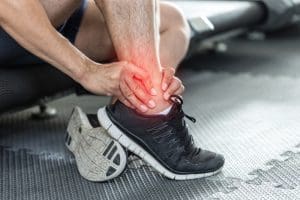 When your ankles hurt from running, it’s important to identify the source of the pain and treat it immediately. Some pains may indicate more serious issues. Continue reading below to learn more about some of the causes of ankle pain and how to relieve it.
When your ankles hurt from running, it’s important to identify the source of the pain and treat it immediately. Some pains may indicate more serious issues. Continue reading below to learn more about some of the causes of ankle pain and how to relieve it.
There’s nothing more frustrating than persistent, nagging pain when you’re trying to run. The repeated impact of each step when running puts stress on our bodies which can result in sprains, tears, fractures, and chronic pain. Thankfully, with the right preventative measures in place, you can avoid a host of ankle-related challenges. Believe it or not, many runners run pain-free all the time because they take steps (more on this below) to avoid and prevent injury.
Ankle pain is one of the most common injuries that stop runners in their tracks. What starts as an annoying twinge can quickly turn into a throbbing mess if you don’t nip it in the bud. So, how do you cope with consistent ankle pain? Let’s take a look at the five of the most common reasons your ankle might be flaring up.
Sore Ankles from Running
Out of all the common running injuries we experience, sore ankles can be particularly brutal. Not only do they cut your training routine short, but they also seep into your day-to-day life. Want to take your dog for a walk? BAM! Ankle pain. It doesn’t have to be that way. Thankfully, there are plenty of ways to prevent, alleviate, and treat your ankle pain so you can get off the sidelines and back in the game.
The hard part is determining which type of running injury you have. Here’s a fun fact: Each foot has 26 bones, 33 joints, and hundreds of tendons and muscles. That’s a lot of moving parts—which can make it difficult to pinpoint exactly where the pain is coming from. Many athletes confuse serious ankle pain for foot cramps, which makes knowing the actual symptoms even more important.
Ankle Pain Symptoms
As with any sport, you’re going to deal with minor aches and pains as a runner—that’s normal. But when the pain doesn’t go away, something could be afoot (sorry, had to!).
Here are noteworthy signs that something more serious is up:
- Sharp pain in the front, back, inside, or outside of the ankle
- Dull, constant aching
- Pinching sensations
- Tenderness or bruising
- Stiffness or swelling in the joint
- Instability in motion
- Reduced ability to run, walk, or bear weight
Not sure how to differentiate between ankle pain symptoms and foot pain in general? Use an ankle pain symptom checker to help you isolate the source of your woes. As always though, Google is not a replacement for a proper medical diagnosis; if you’re concerned about your ankle pain from running, you should get it professionally checked out.
Why Do My Ankles Hurt When Running?
Not sure why, exactly, your ankles hurt when running or post-run? Here are five possibilities.
1. Ankle Strain or Sprain
Strains and sprains are usually the most common reason your ankles hurt when running. An ankle strain happens when a muscle or tendon is overstretched or torn, whereas an ankle sprain is the same injury that affects a ligament. While many other typical reasons for ankle pain stem from overuse, ankle sprains and strains are often caused by a single traumatic injury.
It doesn’t matter if you’re on smooth pavement or an uneven trail—one little misstep or incorrect landing can cause you to painfully roll your ankle. Even if you’re able to get right back on your feet, tiny micro-tears in your muscles and ligaments could add up over time to create a serious injury. Pro tip: Take care of it now.
Strains and sprains might be the most frequent reason your ankles hurt when running, but they’re also the most treatable. As with most injuries, the painful symptoms of rolling your ankle will be easier to treat the quicker the injury is attended to. If you take care of your body at the first sign of pain, you’ll be back on your feet in no time.
2. Ankle Stress Fracture
Stress fractures form when your muscles can no longer absorb the shock of repetitive impact. Instead, tiny cracks form in your bone(s) which eventually crack under the stress. Not fun!
“Shin splints,” Dr. Brad Whitley, PT, DPT explains, “are the most primitive form of a stress fracture. It’s an irritation of the outer lining of the bone. When someone has shin splints they actually have the first symptom of a bone stress injury (BSI).” When left untreated, stress fractures have the potential to completely derail your daily runs and put you in a cast for several weeks. If you’re experiencing intense bruising, tenderness, or can’t run without a sharp pain in your ankle, you should see a doctor and get X-rays. And stop running. This running injury takes about six weeks to heal, so the sooner you’re seen, the better.
3. Ankle tendonitis
tendonitis means inflammation of a tendon that forces it to fray, tear, or swell. There are several different types of tendonitis in your foot region that might make your ankles hurt while you run.
- Tibialis anterior tendonitis: This tendon runs down the front of your shin bone (the tibia) and inserts at the front of your ankle. If this is where you feel ankle pain from running, it’s probably due to repetitive, forceful flexion of the foot. Trouble with your tibialis anterior tendon may also cause those dreaded shin splints (time for an ice bath!)
- Achilles tendonitis: Your Achilles tendon connects the calf muscles to the back of the heel bone (called the calcaneus). If your ankle pain from running is felt on the back of your foot above the heel, it could mean your Achilles is inflamed.
- Posterior tibial tendonitis: This tendon connects the posterior tibial muscle at the back of your shin to the inside of your foot. When irritated, you might feel swelling, warmth, or redness along the inside of your ankle that worsens after
- Peroneal tendonitis: If your outer ankle hurts when running, it could be caused by a swollen peroneal tendon, which connects your lower leg bone (the fibula) to that bony lump on the outside of your ankle (the lateral malleolus).
No matter which type of ankle tendonitis you’re struggling with, they all have similar causes: excessive use, ramping up your mileage too quickly, improper running form, bad footwear, low arches, flat feet, and tight calf muscles. With ankle tendonitis, you’ll typically feel symptoms first thing in the morning or experience sharp pain while cooling down from a run.
 4. Ankle Arthritis
4. Ankle Arthritis
While you might associate arthritis with older athletes, this chronic form of pain can affect runners at any age. There are three different types of foot arthritis that can cause your ankles to hurt when running: osteoarthritis, rheumatoid arthritis, and post-traumatic arthritis. In each case, the joint is damaged or weakened, leading to stiffness and a lack of mobility.
Arthritis isn’t exclusively reserved for hardcore runners, and it doesn’t turn a blind eye toward experienced athletes either. If you notice symptoms, keep track of whether they get progressively worse so you can try to intervene before it’s too late.
5. Ankle Instability and Biomechanics
In some cases, your ankles might just be weak. Ankle instability causes your body’s natural biomechanics to “give out” whenever weight is placed on it, causing chronic pain and frequent injury while running.
Weak and wobbly ankles could be the result of overpronation, which weakens the supporting ligaments in your foot with excessive motion. When you overpronate, the placement of each step is slightly off-balance, causing your foot to roll inward and the shock of impact to be unevenly absorbed. “Some pronation is needed in running for shock absorption, but too much too quickly can cause problems,” shares Whitley.
This type of injury can spread upward and outward through your feet and legs, causing chronic pain that can be debilitating if left untreated. Stability running shoes or motion control shoes might be a good option to keep those wobbly ankles in check. But it’s always best to have your shoes fitted by a professional to ensure you have the proper footwear for your foot type, injury, and activity. Ankle exercises, too, can help you work this often ignored, but important, part of your body.
How Can I Relieve Ankle Pain?
Alright, here’s the section we know you’ve all been waiting for.
If you’re suffering from sore ankles or frequent foot pain when running, your discomfort might be curable, if not at least preventable and treatable. Take a look at the best ways to get your running game back into tip-top shape.
- RICE: All athletes know (or should know) about the tried and true Rest, Ice, Compression, Elevation, (RICE) recovery strategy. This technique is especially effective at treating running pain from sprained ankles. Rest the joint and put as little weight on it as possible; apply an ice pack for 15-20 minutes; compress the ankle to minimize swelling and inflammation; and then elevate your injured ankle above your heart to optimize blood flow.
- NSAIDs: Over-the-counter non-steroidal anti-inflammatory drugs (NSAIDs) are great for providing relief for ankle pain caused by running. You don’t want to get in a habit of taking these regularly, though. Take them as prescribed as soon as possible following your injury for 24-48 hours to make them the most effective.
- Braces: Wearing a brace, supportive wrap, or protective boot can relieve chronic ankle instability and painful stress fractures by limiting your foot’s range of motion.
- Physical therapy: Exercises such as ankle circles, calf raises, and resistant band work can strengthen the muscles around your feet and help prevent sore ankles from running. But if your ankle is in a lot of pain, hold off on stretching and strengthening for 48-72 hours. Be sure to apply a heat pack beforehand to warm up those sore muscles and tendons.
- Steroid injections: You will need to seek out a medical professional to receive a steroid injection to target ankle pain. These strong, anti-inflammatory medicines are a little controversial because it can lead to the development of scar tissue. However, when used as a one-time treatment method, it can be incredibly effective at targeting tendonitis and arthritis ankle pain.
We know – ankle pain is rough. Now you know how to identify it, treat it, and prevent it. At some point in your running career, a sprain or stress fracture will slow you down, but with proper care and determination, you can get through it. And, as always, if you’re in pain when running, it’s always best to STOP and seek advice from a medical professional.
Original and complete article can be found on roadrunnersports.com.








